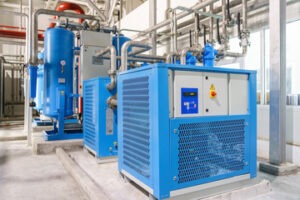
Introduction:
Compressed air is a vital resource in various industries, powering pneumatic tools, equipment, and processes. However, the presence of moisture and contaminants in compressed air can cause significant problems, leading to decreased efficiency, equipment malfunction, and potential damage. This is where compressed air dryers come into play. In this blog, we will explore the importance of compressed air dryers, their types, and their role in ensuring a reliable and efficient compressed air system.
- Understanding Compressed Air Moisture:
- Explaining the sources of moisture in compressed air, including ambient air humidity, compressor operation, and compressed air cooling.
- Highlighting the detrimental effects of moisture, such as corrosion, increased wear and tear, compromised product quality, and decreased equipment performance.
- The Role of Compressed Air Dryers:
- Introducing compressed air dryers as essential components in removing moisture and contaminants from compressed air systems.
- Describing how compressed air dryers work to reduce the dew point, preventing condensation and moisture-related issues.
- Types of Compressed Air Dryers: a) Refrigerated Air Dryers:
- Explaining the operation of refrigerated air dryers, where compressed air is cooled to lower temperatures, causing moisture to condense and separate.
- Discussing the benefits, limitations, and suitable applications for refrigerated air dryers.
b) Desiccant Air Dryers:
- Detailing the working principle of desiccant air dryers, which utilize adsorbent materials (such as silica gel or activated alumina) to attract and trap moisture.
- Discussing the regeneration process and the two main types of desiccant dryers: heatless and heated.
c) Membrane Air Dryers:
- Introducing membrane air dryers, which utilize selectively permeable membranes to remove moisture from compressed air.
- Discussing the advantages, limitations, and typical applications for membrane air dryers.
- Benefits of Compressed Air Dryers:
- Highlighting the advantages of using compressed air dryers, including improved equipment performance, increased product quality, extended equipment lifespan, and reduced maintenance costs.
- Emphasizing the importance of dry and clean compressed air in critical applications, such as food processing, pharmaceuticals, electronics, and automotive industries.
- Factors to Consider When Selecting a Compressed Air Dryer:
- Discussing the key considerations when choosing a compressed air dryer, such as the required dew point, compressed air flow rate, operating conditions, and energy efficiency.
- Highlighting the importance of properly sizing and maintaining the dryer to ensure optimal performance.
- Maintenance and Troubleshooting Tips:
- Providing maintenance guidelines for compressed air dryers, including regular filter replacements, drain inspections, and monitoring of pressure differentials.
- Offering troubleshooting tips for common issues, such as pressure drop, excessive moisture, and abnormal dryer operation.
Conclusion: Compressed air dryers play a crucial role in maintaining the efficiency, reliability, and quality of compressed air systems. By effectively removing moisture and contaminants, these devices help prevent corrosion, equipment damage, and performance issues. Understanding the different types of compressed air dryers and their suitability for specific applications allows you to make informed decisions when selecting and maintaining a dryer for your compressed air system. Investing in a high-quality compressed air dryer is an investment in the longevity and optimal performance of your equipment, ensuring smooth operations and minimizing costly downtime.
